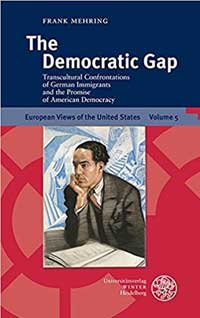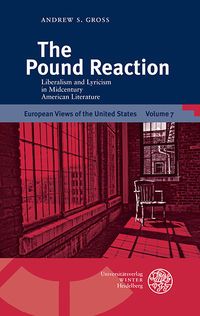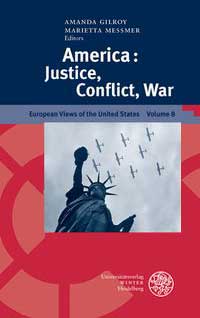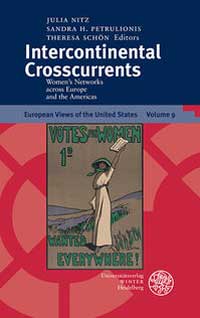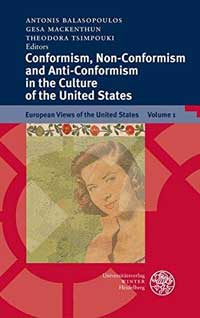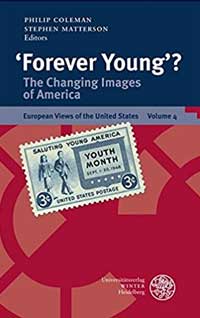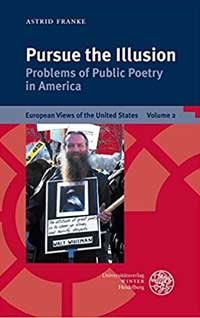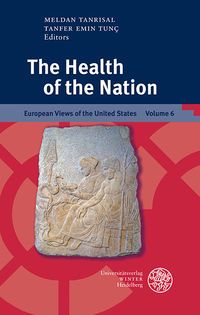Ada Savin, ed., Journey Into Otherness: Essays in North American History, Culture and Literature
Ada Savin, ed., Journey Into Otherness: Essays in North American History, Culture and Literature. Series: European Contributions to American Studies. Amsterdam: VU University Press, 2005. ISBN: 90 5383 955 0 (ECAS no 61)
Journey Into Otherness collects some of the papers presented at the international conference entitled "Regarding the 'Other': Inter-ethnic Dynamics in North America," which was held at the University of Versailles in 2003. The essays in the volume focus on the complex dynamics of inter-ethnic and inter-racial contacts in American history, culture and literature. The interdisciplinary nature of the volume allows readers to view the topic of the ever-changing relations between ethnic communities on the North American continent from different, intersecting and complementary, viewpoints. Importantly, rather than dwell on the traditional opposition between mainstream U.S. culture and minorities, the authors in the volume adopt a trans-ethnic, trans-national perspective that sheds light on various forms of interaction-alliances as well as conflicts-between racial and ethnic groups in North America.
The volume is divided into four sections-"Southern 'Others'," "Canadian 'Others'," "The Mexican Borderlands," and "Crossing Boundaries"-and opens with a brief introduction that outlines its conceptual and theoretical framework. In the introduction, Ada Savin explains that the time has come to pay attention to the American inter-ethnic scene and, alluding to the work of William Boelhower, specifies the ethnic kinesis in American society as the common thread among the seventeen essays in the volume. The editor acknowledges that ethnic groups in the U.S. and Canada are becoming increasingly transnational and that racial blurring-whether biological or symbolical-constitutes a widely accepted norm. Savin concludes her introduction to the volume with an open-ended question about whether or not ethnic identity will become a matter of subjective choice in the future.
Section 1, entitled "Southern Others," includes four essays. The first essay by Bernard Vincent constitutes a historical investigation into the institution of slavery among Indians. Vincent employs the Cherokee nation as a case study and traces the evolution of the institution of slavery in this tribe since the period that preceded the arrival of European settlers. Importantly, the critic discusses slave trade among the Cherokees not only as a social practice that involved economics, but also as a culturally significant and politically motivated practice. The second essay by Nathalie Dessen concentrates on American Louisiana and uses the region as an example to illustrate the elaboration of cultural identities in North America through the interaction of the various "Others" that peopled it. Dessen's essay focuses on the main ethnic groups that composed the Louisiana population in the early nineteenth century, and tries to assess the conflicts that opposed them and to detect the influences they exerted on each other. Ultimately, it attempts to analyze the interaction between these various ethnic groups which, the author claims, gave birth to a syncretic culture through a slow process of Creolization. Rodger Payne's essay also makes the Louisiana region its subject, but focuses on the "Italian Other" in south Louisiana. Payne's discussion offers a vivid picture of the cultural context that informed Italian immigrant life in rural south Louisiana when Tony Musco entertained a saint and began a devotion. Payne uses the example of Musco to illustrate the ways in which immigrants of Italian origin used traditional forms of Italian folk Catholicism to respond to the rhetoric of "Otherness" that marked them as an in-between people. As Payne insightfully observes, the agency of an obscure patron (through devotional activity) not only instigated the immigrants' self-definition but also subsequently led to "race mixing," as Americans of Italian ancestry began to claim their place within the larger social fabric. The last essay in this section, Susan Koshy's, is framed within whiteness and ethnic studies and examines the complex and ambivalent racial strategies of the Chinese in Mississippi in the period between 1870 and 1950. Koshy's brief but extremely suggestive essay emphasizes the dialectical relationship between whiteness, blackness and Asianness, thereby critiquing the dependence on the black/white binary. The author describes the emergence of Asian Americans as an intermediary minority group as a complex process of resistance and complicity-a process that involved mimicry, dissimulation, opposition, challenge and evasion.
Section 2, "Canadian 'Others'," opens with Jean-Michel Lacroix's essay which, as its title suggests, questions whether there can be a new Canada/Quanada partnership. Lacroix's essay outlines the characteristics of Canada's multicultural society and examines the challenges cultural diversity poses to national unity. Lacroix resists simplistic interpretations of Canada's ethno-cultural pluralism and contends that it is neither a uniform concept nor a monolithic reality but one that remains to be constructed and that is continuously interpreted and reinterpreted as common values are negotiated. The challenges of multiculturalism also surface in Sandrine Ferré-Rode's essay that examines Frederick Philip Grove as a champion for Canada, whose views on immigration challenged Canadian society's xenophobic sentiments at the time. Ferré-Rode stresses Grove's comparison between Canada and the U.S., but also illustrates, through a close reading of Grove's lectures, the ways in which he presented the U.S. as a foil to Canada. As Ferré-Rode concludes, Grove's vision of French Canada as a federation, although sketchy and idealistic, is, nonetheless, historically and culturally appropriate. The third essay in this section, Greg Robinson's discussion of the historical encounters between Japanese Canadians and French Canadians, picks up on some of the observations Ferré-Rode makes and traces the modern development of Canada, posing several questions on the "essence" of Canadian society. Robinson's essay does not offer a definitive answer to the question of whether the presence of Japanese Canadians in Quebec has fostered a special relationship between them and the French Canadian majority. Instead, the critic concludes that while the two communities remain fairly separate they also gravitate toward each other, thus holding the promise of an entente cordiale that could potentially terminate racial tension. Last, Mathieu Besmier's essay on Canada's capital-Ottawa-relates the issue of the "Other"-at the core of Ottawa's history-with the issue of "Otherness" in Canada at large and with the construction of Canadian identity. Besmier is highly critical of the physical (geographic), linguistic and religious separation of the English- and French-speaking populations of Ottawa and views Ottawa as emblematic of the Canadian confederation's quest for identity. Besmier's final remarks problematize the view of Ottawa and, by extension, Canada as multi-ethnic, multicultural, and open to the world.
Part 3, "The Mexican Borderlands," begins with an essay by Anne-Marie Brenot on the genre of casta painting and the way in which it represented various types of métissage in the New World (New Spain). In addition to Brenot's detailed discussion of three casta paintings by Miguel Cabrera (De Espanol y d'India, Mestiza; De Chino cambujo y d'India, Loba; and De Negro y d'India, China cambuja), the essay's important contribution is the argument it makes about the social, political, and cultural role these paintings played in the New World colonial societies. The author contends that casta painting was not merely about depicting social reality. In Brenot's words, casta paintings reflected the de facto existence of a multi-racial society that was aware of its distinctiveness with respect to the societies of the Old World. The second essay in this section by Lisbeth Haas views the California borderlands from the perspective of indigenous ethnic and interethnic groups whose interactions enabled things Spanish, like the borderlands missions, to be infused with a strong indigenous content. Haas' essay offers a rather convincing explanation for the way in which Catholicism and the missions became known through the multiple translations of words and concepts and through the interpretations attempted by native scholars, authorities, and common people. Haas particularly focuses on the Chumash revolt (1824) which, she argues, illustrates the crucial role ethnic and interethnic relations played in sustaining an extraordinary act of resistance to conquest. The third contributor in this section, Mel Fearon, turns his attention to the Irish experience in Texas-in particular, their encounters with Mexicans. The author specifically focuses on the pre-famine Irish who settled in Mexico in the colonies of San Patricio and Refugio in the Province of Texas in the late 1820s and, by paying close attention to both state policies and local community responses, he re-tells the story of how Mexico's Far North became the American Southwest. Even though the essay is well grounded on (and often highly critical of) recent historical scholarship on the matter of cross-cultural and cross-class alliances, the concluding remarks the author makes in referring to the Irish immigrant experience in the U.S. leave unanswered important questions as to the different national projects Irish immigrants embraced. Last, the essay by Ramón A. Gutiérrez provides a historical genealogy for the theory of internal colonialism, traces the theory's origins in Latin American theories of dependency and underdevelopment, and examines its extension, diffusion, and transformation among Chicanos and Blacks. Gutiérrez explains the reasons because of which racial minorities in the U.S. found the theory of internal colonialism compelling, and traces the theory's relevance to economics, sociology, and political economy, as well as its significance for African American and Chicano studies.
The last section, "Crossing Boundaries," is the longest one in the volume and, as its title suggests, it transgresses the spatial and corresponding cultural boundaries the thematic divisions among the other sections in the volume purposefully maintain. The first essay by Fabienne Quennet focuses on the literary representation of adopted captive figures in Robson's Ride with the Wind (1982) and Blake's Dances with Wolves (1988). Brief though it may be, the essay, nevertheless, begins with a long theoretical introduction to the topic of transculturation in the Western frontier; then, it proceeds to specific commentary on the two movies. Quennet observes that the process of adopting captives constitutes an act of identity change and boundary crossing, and explains that the only means of surviving Indian captivity was transculturation-a practice punished by white settlers. The critic subsequently turns her attention to the topic of white-native intermarriage and discusses it as a personal process determined by feelings rather than as a shocking phenomenon. Ultimately, Quennet concludes that the adopted captivity motif mirrors the ambiguity inherent in white-native relationships and presents an undesirable otherness that white dominant culture both needs and needs to eradicate. The second essay in this section examines another case of border crossing by discussing Gayl Jones' Mosquito, a novel centered on African-American and Chicano interaction. The author, Heiner Bus, mainly focuses on the main character's (Mosquito) involvement in the "new Underground Railroad" and illustrates the ways in which Jones exploits some of the highly mythologized features of the historical Underground Railroad. Overall, Bus' essay is an insightful close reading of Jones' novel that interprets individual cases of ethnic interaction (between Mosquito and Delgadina) as a productive movement within and beyond the stereotypes of individual and group identities. Matthew Briones' essay on Charles Kikuchi also contributes to the discussion of ethnic interaction by examining the representation of African Americans in the diaries of Kikuchi, a second-generation (Nisei) son of Japanese immigrants. Briones closely reads Kikuchi's diaries that record his World War II experiences to illustrate the common points of intersection and the discrete boundaries of exclusion in the experiences of Blacks and Japanese in America. For Kikuchi, as Briones explains, the "American Dilemma" could be the "Negro question" as much as the "Japanese question"-a dilemma that could not be automatically solved by assimilating non-Whites. Similarly to Briones, Jelena Sesnic delineates some of the possible implications of the cultural exchange between "Asian America" and "African America," but her essay aims at offering a synoptic overview of some junctures in the Asian American literary canon. Sesnic explores the workings of the ethnic masculine self-creation-whether through confrontational or cooperative modes of engagement with African American cultural elements. The critic's close reading of Bulosan's America Is in the Heart (1943), Okada's No-No Boy (1957), and Chin's play The Chickencoop Chinaman suggests that male Asian American characters attempt to construe an alternative masculinity through a significant blend of strategies prompted by social coercion and by voluntary choices and exchanges with African American characters. Finally, Ada Savin concludes the volume's exploration of inter-racial identities and contacts by discussing James McBride's The Color of Water, focusing in particular on the dialectics of Black-Jewish inter-personal relationships. As the critic reveals, The Color of Water debunks some widely circulated myths about Black and Jewish group identity, as well as collective and individual memory. In Savin's view, the uniqueness of the specific autobiographical narrative is that it suggests the possibility of bridging racial identities, thus transcending deeply embedded racial divides.
Overall, Journey Into Otherness is an important contribution to the exploration of inter-ethnicity. Responding to the dialogue initiated by such works as Boelhower's Through a Glass Darkly (1987), Budick's Blacks and Jews in Literary Conversation (1999), Biale's Insider/Outsider (1998), and Sollors' Neither Black nor White yet Both (1997), the seventeen essays in the volume offer keen insights into a relatively untapped and challenging domain. Ultimately, by considering the dialectics between ethnic and mainstream America from the perspective of inter-ethnic and inter-racial contacts, Journey Into Otherness points to new directions in the study of the North American ethno-racial scene.
Eleftheria Arapoglou.
Aristotle University of Thessaloniki, Greece


